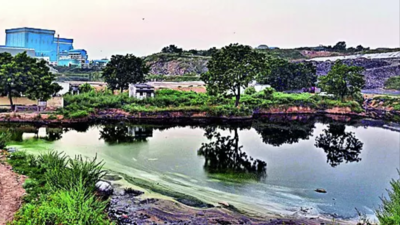- News
- City News
- Hyderabad News
- Leaky Hyderabad landfill poses severe risk of microplastic pollution
Trending Topics
Leaky Hyderabad landfill poses severe risk of microplastic pollution

Researchers found 21 microplastics per litre of leachate at the Jawaharnagar dump yard in city
HYDERABAD: The legacy dump at Jawaharnagar, which has been haunting thousands of families in the vicinity for decades, is turning out to be Hydera bigger problem than perceived as new research suggests heavy presence of microplastics in the leachate from the yard.
Microplastics are extremely small, degenerated plastic particles 5mm and below, which can enter the food chain, subsoil, groundwater and cause health disorders.
The study, by researchers from NIT Andhra Pradesh, has found evidence of 15 'items' of microplastics per litre, on an average, of water from the liquid samples collected around the dump.
The paper was published in the 'Science Direct' journal by researchers Vijaykumar Sekar and Baranidharan Sundaram, who had collected samples from the leachate pools at four locations adjacent to the dump yard.
At one of the locations, 21 items of microplastics per litre were found.
They said that the majority of microplastics found were fibres (83%) and fragments (11%), thereby indicating that these could have come from plastic ropes, fabric, net, etc or were degenerated plastic debris from the waste dumped at the site. The nature of these microplastics were polyethylene (PE), polyethylene terephthalate (PET), and polypropylene (PP) and low-density polyethylene (LDPE), etc.
The paper further said these plastics could have possible impact on the environment around the dump yard. While these could seep into the groundwater and contaminate it, even before it reached the water table, their presence in subsoil could change the density, organic composition and also poison it with harmful toxins they carry on their surface.
Speaking about the findings, assistant professor Sundaram said, "It is a matter of concern because unlike plastic waste, microplastics can't be seen with the naked eye and often overlooked as a problem."
"Malkaram Cheruvu abutting the Jawaharnagar dump yard has been contaminated with leachate. It is further linked to Dammaiguda Cheruvu and Cheerala Cheruvu. So, they too could potentially be plagued with microplastics. The leachate has been entering the lakes in vicinity, both through surface run-offs and through groundwater for years. A larger study must be conducted to see where all such microplastics can be found as these lakes eventually empty into Musi," Donthi Narasimha Reddy, a climate change expert, told TOI.
It is concerning that plastic 'weathering' was happening in such a short span of time, Reddy said. "Weathering of plastics usually happens due to sun, heat and wind, but occurs over several years. From previous studies we know that majority of the plastic dump and fabric came to the dump in the last decade or so, owing to the boom in plastic consumption. Clearly, some other chemical compositions at the legacy dump is hastening the weathering of plastics into microplastics," he added.
Microplastics are extremely small, degenerated plastic particles 5mm and below, which can enter the food chain, subsoil, groundwater and cause health disorders.
The study, by researchers from NIT Andhra Pradesh, has found evidence of 15 'items' of microplastics per litre, on an average, of water from the liquid samples collected around the dump.
The paper was published in the 'Science Direct' journal by researchers Vijaykumar Sekar and Baranidharan Sundaram, who had collected samples from the leachate pools at four locations adjacent to the dump yard.
At one of the locations, 21 items of microplastics per litre were found.
They said that the majority of microplastics found were fibres (83%) and fragments (11%), thereby indicating that these could have come from plastic ropes, fabric, net, etc or were degenerated plastic debris from the waste dumped at the site. The nature of these microplastics were polyethylene (PE), polyethylene terephthalate (PET), and polypropylene (PP) and low-density polyethylene (LDPE), etc.
The paper further said these plastics could have possible impact on the environment around the dump yard. While these could seep into the groundwater and contaminate it, even before it reached the water table, their presence in subsoil could change the density, organic composition and also poison it with harmful toxins they carry on their surface.
Speaking about the findings, assistant professor Sundaram said, "It is a matter of concern because unlike plastic waste, microplastics can't be seen with the naked eye and often overlooked as a problem."
"Malkaram Cheruvu abutting the Jawaharnagar dump yard has been contaminated with leachate. It is further linked to Dammaiguda Cheruvu and Cheerala Cheruvu. So, they too could potentially be plagued with microplastics. The leachate has been entering the lakes in vicinity, both through surface run-offs and through groundwater for years. A larger study must be conducted to see where all such microplastics can be found as these lakes eventually empty into Musi," Donthi Narasimha Reddy, a climate change expert, told TOI.
It is concerning that plastic 'weathering' was happening in such a short span of time, Reddy said. "Weathering of plastics usually happens due to sun, heat and wind, but occurs over several years. From previous studies we know that majority of the plastic dump and fabric came to the dump in the last decade or so, owing to the boom in plastic consumption. Clearly, some other chemical compositions at the legacy dump is hastening the weathering of plastics into microplastics," he added.
Start a Conversation
FOLLOW US ON SOCIAL MEDIA
FacebookTwitterInstagramKOO APPYOUTUBE










